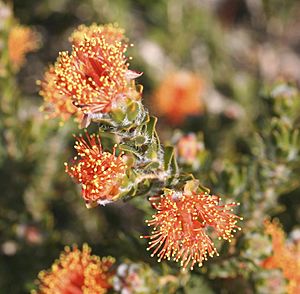Eremaea beaufortioides facts for kids
Quick facts for kids Eremaea beaufortioides |
|
|---|---|
 |
|
| Scientific classification | |
| Genus: |
Eremaea (plant)
|
| Species: |
beaufortioides
|
| Synonyms | |
|
Melaleuca beaufortioides (Benth.) Craven & R.D.Edwards |
|
Eremaea beaufortioides is a special kind of plant that belongs to the myrtle family. You can only find it growing naturally in the south-west part of Western Australia. It's a spreading shrub, which means it grows wide rather than tall. It has leaves that are shaped like ovals or eggs, and it blooms with bright orange flowers in the spring. These flowers usually appear in small groups of one to six at the ends of branches that grew the year before.
Contents
What Does It Look Like?
Eremaea beaufortioides is a shrub that spreads out and can grow up to about 2.2 meters (about 7 feet) tall. Its leaves are small, usually between 2.9 and 5.6 millimeters long (less than a quarter inch). They are also about 1.4 to 4.2 millimeters wide. The leaves are flat and can be thin and long, or wider and egg-shaped. Sometimes, you can see up to 7 veins on the underside of the leaves. The size and shape of the leaves can be a bit different depending on which type of Eremaea beaufortioides it is.
Its Bright Orange Flowers
The flowers of this plant are a beautiful orange color. They grow in groups of up to six at the very ends of branches that grew during the previous year. Each flower has 5 sepals, which are like small leaf-like parts that protect the bud. It also has 5 petals, which are the colorful parts of the flower, measuring about 3.5 to 5.7 millimeters long.
The bright orange color of the flower comes from its stamens. Stamens are the parts of the flower that produce pollen. In Eremaea beaufortioides, the stamens are grouped into 5 bundles. Each bundle can have between 34 and 48 stamens! This plant flowers from September to December. After the flowers, it produces woody capsules, which are like small seed pods. These capsules are smooth and shaped a bit like a barrel. They are usually 8 to 11 millimeters long and 2.8 to 6.1 millimeters wide.
Plant Naming and Types
How It Got Its Name
The plant Eremaea beaufortioides was first officially described in 1867 by a scientist named George Bentham. He wrote about it in a book called Flora Australiensis. The second part of its scientific name, beaufortioides, hints that this plant looks similar to another type of plant called Beaufortia. This is because the Ancient Greek word eîdos means "form" or "likeness."
Different Varieties
There are three main types, or varieties, of Eremaea beaufortioides:
- Eremaea beaufortioides var. beaufortioides: This type has thin leaves with 5 or more veins. Its flowers have a smooth part called a glabrous hypanthium (the cup-shaped base of the flower).
- Eremaea beaufortioides var. lachnostanthe: This variety has thin leaves with 3 veins. Its flowers have a very hairy hypanthium.
- Eremaea beaufortioides var. microphylla: This type has small, thick leaves. It has fewer than 3 veins, and sometimes they are hard to see.
Where It Lives
Eremaea beaufortioides is found in a region of Western Australia called the Irwin district. It grows in several different natural areas, including the Avon Wheatbelt, Geraldton Sandplains, Swan Coastal Plain, and Yalgoo biogeographic regions. It likes to grow in sandy soil that is on top of a hard, reddish layer called laterite.
Is It Endangered?
The Western Australian Government's Department of Parks and Wildlife has looked at Eremaea beaufortioides. They have classified it as "not threatened," which means it is not currently in danger of disappearing.
Growing It in Gardens
Eremaea beaufortioides is a very attractive plant that people might want to grow in their gardens. However, it can be a bit tricky to grow, especially in places that are very humid (wet and sticky). Even though it's the toughest plant in its group, it often needs to be "grafted" to grow well in humid areas. Grafting is a special technique where parts of two plants are joined together so they grow as one. This plant needs a sunny spot and soil that drains water very well.

